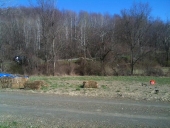

J D Horn wrote:Brendan,
Understanding that you will need to transition to non-chemical treatment, maybe natural methods can provide a bridge.

Chris Stelzer wrote:
I would say density is a big part of mob grazing, but the most important factor is recovery period. How long you let the grass recover. You can overgraze any grass plant and it will be healthy. It just comes down to how long that plant has to recover. If you allow your cattle to graze a grass plant into the dirt, then your gonna need a hell of a recovery period. However, if you let the cattle just take the "tips" of the plant or one bite, then that grass plant can recover much more quickly. This is what we are doing on Greg's farms right now. The cows have very high nutritional requirements because they are about to have their cavles, so we are just taking the "tips" of the grass plants, and moving on to the next paddock. Since you are just starting, shoot for 60% eaten, 30% grass trampled on the ground, and 10% left standing. I can't tell you how big to make your paddocks, so the 60,30,10 rule is a good place to start. Also, you will know your grass plants are fully recovered when you can find 4 leaves on a plant.
As far as electric fence. Put up an electric fence that they will run into when they go to water or something. This will train them. Then you can use it to create paddocks. Also, buy polybraid, NOT polywire from Powerflex Fence Company. I don't know what the "hot wire trick" is, sorry.
Greg doesn't have a tractor, or any heavy machinery. He has a 4 wheeler, mule and pickup truck. We use a 100 gallon water tank to water 250 head of cattle this late fall, winter and spring. Once it gets above 85 degrees, Greg likes to use his ponds, or larger water tanks. He also has AWESOME pressure, that's why we can get away with a 100 gallon tank for 250 head. Since you have 10 head, you would be fine with a 100 gallon tank if you had even 30 PSI I'm guessing.
In conclusion it call comes down to management. The more time your grass can recover, the better (to a certain extent). You'll be happier, and so will your animals. Not to mention the food the produce for you will be of higher quality.
I'd highly recommend you read both of Greg's books. You can find them at www.greenpasturesfarm.net



Chris Stelzer wrote:I can help answer some of your questions. I'm currently an intern at Greg Judy's farms.
Using a wormer is providing a crutch for your cattle. The more you worm them, the more they need to be wormed. The key to to rotate your cattle through different paddocks, this will dramatically cut down on parasite issues. Second, you need cattle that have the correct phenotype to perform on grass. That means that the cattle should be short (lower to the ground), and wide, you want to see them with a BIG gut. They should look like a whiskey barrel with sticks for legs (basically). Ivomec is some of the nastiest shit out there. You are not only treating your cattle, you are vicariously putting down ivomec on your soils. This kills all of your soil life, and generally it's just toxic shit. There are some ways to control flys that were already mentioned by the folks above. Greg also have 350 bird houses throughout his farms. These attract tree swallows, which can eat 3000 flys a day. I also think chickens would be great too, but then you have to feed and manage the chickens etc.
Going back to you comment on not having the "resources" to do this. This comes down to you. Greg built his operation by working his ass off. He had a 40 hour a week job in town, and he was managing his cattle everyday, after work. Then he would build fence on weekends and after work. So for you to say that you don't have the "resources" comes down to your attitude. If you think you can do it, you can. If you don't think you can do it, you can't. All you would need to do is put in 5-7 days worth of paddocks on the weekend, and when you get home from work, roll up a reel of polybraid. It's that easy. Then move the water tank every few days.
If you have any other questions I'd be happy to answer them for you.


Walter Jeffries wrote:Nice cock.

John Polk wrote:BEWARE! If any of your chickens look anything like this guy,

Mac McCarty wrote:
Why are those prices out of line? I can get an 18-week-old ready-to-lay certified organic pullet for $7.50. After a year of laying they are worth around $1 as a live bird from the farm (or whatever I could convince somebody to pay). I could dress them out and sell them as organic stewing hens for $6, maybe $7, each. (Comparable to $3 per lb). What makes you think that live layer is worth more than $5?

tel jetson wrote:
how well does your feed keep over two months? I've found that two weeks is about all I can store feed before it goes stale and the birds won't touch it until they're really hungry. sort of turned me off buying feed at all.